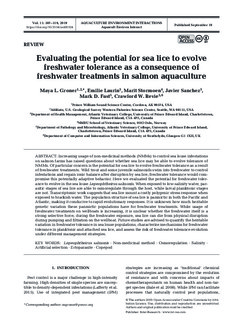| dc.contributor.author | Groner, Maya L. | |
| dc.contributor.author | Laurin, Emilie | |
| dc.contributor.author | Stormoen, Marit | |
| dc.contributor.author | Sanchez, Javier | |
| dc.contributor.author | Fast, Mark D. | |
| dc.contributor.author | Revie, Crawford W. | |
| dc.date.accessioned | 2019-10-08T07:24:53Z | |
| dc.date.available | 2019-10-08T07:24:53Z | |
| dc.date.created | 2019-10-07T12:29:47Z | |
| dc.date.issued | 2019 | |
| dc.identifier.citation | Aquaculture Environment Interactions. 2019, 11 507-519. | nb_NO |
| dc.identifier.issn | 1869-215X | |
| dc.identifier.uri | http://hdl.handle.net/11250/2620740 | |
| dc.description.abstract | Increasing usage of non-medicinal methods (NMMs) to control sea louse infestations on salmon farms has raised questions about whether sea lice may be able to evolve tolerance of NMMs. Of particular concern is the potential for sea lice to evolve freshwater tolerance as a result of freshwater treatments. Wild trout and some juvenile salmonids swim into freshwater to control infestations and regain ionic balance after disruption by sea lice; freshwater tolerance would compromise this potentially adaptive behavior. Here we evaluated the potential for freshwater tolerance to evolve in the sea louse Lepeophtheirus salmonis. When exposed to low-salinity water, parasitic stages of sea lice are able to osmoregulate through the host, while larval planktonic stages are not. Transcriptomic work suggests that sea lice mount a costly polygenic stress response when exposed to brackish water. The population structure of sea lice is panmictic in both the Pacific and Atlantic, making it conducive to rapid evolutionary responses. It is unknown how much heritable genetic variation these panmictic populations have for freshwater treatments. While usage of freshwater treatments on wellboats is increasing, it is unclear whether the freshwater itself is a strong selective force; during the freshwater exposure, sea lice can die from physical disruption during pumping and filtration on the wellboat. Future studies are advised to quantify the heritable variation in freshwater tolerance in sea louse populations, characterize mechanisms for freshwater tolerance in planktonic and attached sea lice, and assess the risk of freshwater tolerance evolution under different management strategies | nb_NO |
| dc.description.abstract | Evaluating the potential for sea lice to evolve freshwater tolerance as a consequence of freshwater treatments in salmon aquaculture | nb_NO |
| dc.language.iso | eng | nb_NO |
| dc.rights | Attribution-NonCommercial-NoDerivatives 4.0 Internasjonal | * |
| dc.rights.uri | http://creativecommons.org/licenses/by-nc-nd/4.0/deed.no | * |
| dc.title | Evaluating the potential for sea lice to evolve freshwater tolerance as a consequence of freshwater treatments in salmon aquaculture | nb_NO |
| dc.type | Journal article | nb_NO |
| dc.type | Peer reviewed | nb_NO |
| dc.description.version | publishedVersion | nb_NO |
| dc.source.pagenumber | 507-519 | nb_NO |
| dc.source.volume | 11 | nb_NO |
| dc.source.journal | Aquaculture Environment Interactions | nb_NO |
| dc.identifier.doi | 10.3354/aei00324 | |
| dc.identifier.cristin | 1734442 | |
| dc.relation.project | Fiskeri- og havbruksnæringens forskningsfond: 901438 | nb_NO |
| cristin.unitcode | 192,16,3,0 | |
| cristin.unitname | Institutt for produksjonsdyrmedisin | |
| cristin.ispublished | true | |
| cristin.fulltext | original | |
| cristin.qualitycode | 1 | |

